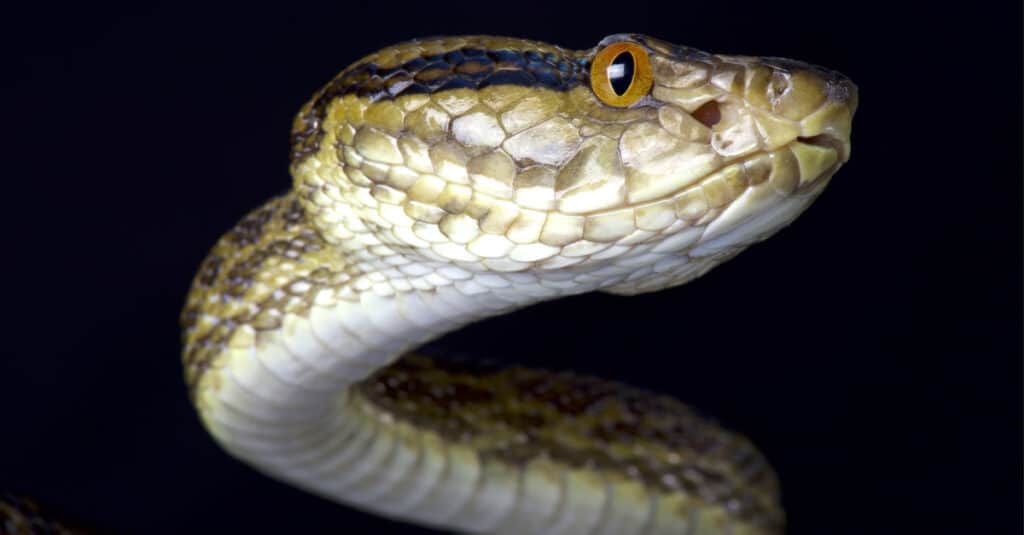Japan isn’t a place often known for its snakes, but many people would be surprised at its reptilian diversity! Large, small, venomous, and nonvenomous snakes live almost everywhere in Japan. In fact, there are over 47 species of snake native to Japan’s eight distinct regions. Today, we are going to focus on one of them. Let’s discover the largest snake found in Japan!
What is the largest snake found in Japan?

The Hime habu is likely the largest snake on record in Japan.
©reptiles4all/Shutterstock.com
The largest snake in Japan is likely the Hime habu, otherwise known as the Okinawa pitviper.
Japan is home to many great snakes, although most of them are rather small when compared to other parts of the world. Still, one snake stands out as the largest of them all. The Hime habu (Ovophis okinavensis) is a venomous pit viper native to the country and is one of the most dangerous snakes in Japan.
Most habus are pale and come in shades of greenish-brown or yellowish-olive and have large brown spots across their backs and smaller spots down their sides. Additionally, the habu’s head is flattened and large, resembling an arrowhead.
On average, the habu grows to around 5 feet long, although the record is much larger. Finding an authoritative source is tough, but some reports have a record-breaking habu growing to a massive 7.9 feet. The only other snake that is similarly sized in Japan is the Japanese ratsnake, but even the largest rat snakes on record in Japan can’t compete with the record-holding habu. Another source places the record for a habu at 9.8 feet, although this is tough to confirm.
Where does the Hime habu live?

The Okinawa habu lives in the Ryukyu Islands of Japan in the Okinawa region.
©feathercollector/Shutterstock.com
The Hime habu is native to Japan but is only found in the Okinawa region of the country. More specifically, the habu is only found in the Ryukyu Islands, particularly Okinawa and the Amami Islands. The exact place it is found usually impacts what people refer to it as, with names including Hime habu, Okinawa pitviper, Okinawa habu, Hon habu, habu, kufah, and Niibuyaa.
Within its distribution, the habu is a generalist and can be found in a variety of habitats. The most common habitats include open woodland, forests, mountains, fields, and especially farming areas. In each habitat, they generally prefer areas with water sources nearby. Habu can also be found in human establishments and are dangerous when close to humans.
What kind of venom does the Hime habu have?

Habu venom is dangerous, but it is rarely deadly.
©Yuya Wakita/Shutterstock.com
Like all pit vipers, the habu has a potent venom that can be extremely dangerous. Most vipers have a similar venom made up of hemotoxins and cytotoxins. Hemotoxins particularly impact the blood, while cytotoxins usually impact tissue. Generally, habu venom isn’t deadly, but it is still considered a medical emergency.
The most common reason people are bitten by the habu is by accident. Since these snakes can be sluggish, especially at night, they are occasionally stepped on when they aren’t moving fast enough. When a surprised snake is stepped on, it can bite as a defense mechanism. Additionally, habus occasionally bite people as they are working in pastures and farms.
What does the habu eat?
Despite their size, habus eat relatively small prey. Their most common food sources are rodents and other vertebrates, particularly those found in sugar cane fields and around human establishments.
Interesting facts about the habu
- The habu can choose whether to give birth to live babies or lay eggs, depending on the situation
- Habus can be rather aggressive snakes if messed with
- The longest known habu was measured at 7.9 feet long
- Habu venom can cause nausea, vomiting, hypotension, and possibly death
- Only 1% of habu bites are fatal
The photo featured at the top of this post is © reptiles4all/Shutterstock.com
Discover the "Monster" Snake 5X Bigger than an Anaconda
Every day A-Z Animals sends out some of the most incredible facts in the world from our free newsletter. Want to discover the 10 most beautiful snakes in the world, a "snake island" where you're never more than 3 feet from danger, or a "monster" snake 5X larger than an anaconda? Then sign up right now and you'll start receiving our daily newsletter absolutely free.
Thank you for reading! Have some feedback for us? Contact the AZ Animals editorial team.






